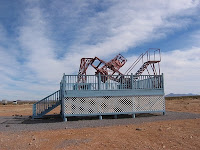
Portal has long been one of may favorite spots in Arizona. It is a little town, or more accurately a cluster of ranch properties, nestled at the mouth of Cave Creek Canyon on the east slope of the Chiricauhua mountains of southeastern Arizona. Amazingly, they have a webpage. A portal if you will, to
Portal. As an interesting side note, Laura, my sister-in-law who inspired the Lost Pleiad Observatory (
you can read the story here), met her husband Mack, while on a caving trip with me near Portal. These are some of the photos from inside Crystal Cave taken on that trip-


Portal is also home to the
Arizona Sky Village, a small development of homes with observatories, as well as a number of other private observatories. I travelled to Portal on Friday afternoon with my good friend Jerry Farrar to spend the new moon weekend observing. The weather reports were good for Friday night, but sketchy for Saturday and Sunday. This area has undoubtedly some of the most pristine dark skies anywhere in the continental U.S. On a clear moonless night, it is not uncommon to have a naked eye limiting magnitude of 7 to 7.5 depending on the observer. In amateur astronomy, naked eye limiting magnitude refers to the faintest stars that can be seen with the unaided eye near the zenith on clear moonless nights. The greater the number, the fainter the object. By way of comparison the outskirts of Tucson may have a limiting magnitude of 4 to 5. If I recounted here some of the things that I have observed from Portal, you would probably stop reading thinking such things are not possible. Consider, for a moment, the possibility of an unfiltered observation of the Horsehead nebula...heresy? Hardly. It was a reality- confirmed by 3 different observers.
Friday night was a very clear night, with the milky way burning bright right down to the southern horizon. While the seeing was above average, the transparency was close to perfect. In practical terms what this means is that the atmosphere was slightly unsteady, making stars twinkle and critical detail in planetary observation a little tricky. At the same time, the perfect transparency allowed for very faint objects such as nebula and galaxies to be obseved.
I have been working on observing the Caldwell objects for some time, and Caldwell 51 has been very difficult. Despite several tries I have never seen this object, until tonight! Caldwell 51, which is IC 1613 is a dwarf irregular galaxy in Cetus. It is an extremely difficult visual object and is only visible as a subtle brightening. Despite being listed as Magnitude 9.2, this ranks among the most difficult of visual observations I have made. In fact, once I had the correct star field, it took several minutes and slowly panning around to detect the brightening.

Jerry was using his 12 inch SCT to observe faint galaxies in Fornax, so I decided to join him for a little while observing the same galaxies in my 9.25 inch SCT. I made this sketch of NGC 1316, which I scanned and inverted to simulate the eyepiece view. While NGC 1316 is the brightest galaxy in this sketch, NGC 1317 is visible just below 1316, and NGC 1310 is visible as a faint circular haze to the upper right . NGC 1316 has a magnitude of 8.2, while 1317 is magnitude 10.8, and 1310 is magnitude 12.5.
In addition, to these galaxies, I observed several others in Fornax.
NGC 749 - a faint magnitude 12.7 galaxy, slightly oval, with a bright core
NGC 823 - another magnitude 12.7 galaxy, elongated east-west with a star attached to the east end of the galaxy. (At first we thought this could be a supernova but a check of the DSS image revealed a star)
NGC 986 - An oval shaped galaxy with a bright nucleus extending about 2/3 of the length of the magnitude 10.9 galaxy
NGC 1097 - A very attractive elongated galaxy, with a bright nucleus and an oval halo. Just north of the 9.2 magnitude galaxy, its companion NGC 1097a is visible as a fuzzy spot.
Before leaving Fornax, I observed NGC 1049. This is a 12.9 magnitude extragalactic globular cluster- it is actually the brightest globular cluster (of 4) visible in the Fornax dwarf galaxy. The photo to the left belies the faint smudge that was in the eyepiece. It had the appearance of a star with a very faint halo. It is likely that this object would appear as a star from all but the darkest locations. The faint halo was easy to miss. The Fornax Dwarf galaxy itself has too low a surface brightness to be observed.
Mars was blazing high in the east by about 11:30, so after viewing a few more galaxies (such as NGC 2292/2293 and NGC 2295 in Canis Major), I decided it was time to sketch Mars.
Time of sketch: 0700 UT, 1-16-10
RA: 9h 15m 1.9s Dec: +20 deg. 27'
Illumination: 99% Magnitude: -1.1
Distance: .679 au (5.6 light minutes!) Size: 13.8 arcseconds
Mars is almost as large as it will be this aparrition. Seeing was just above average, and bright planets do not benefit from dark skies. So despite the world class location, the observation of details was typical of that seen from the Lost Pleiad Observatory. The polar cap was bright, as was the limb, with the Hellas basin area also bright. Syrtis major was promienet as was again, the dark collar below the north polar cap.
On Saturday, we woke up and the sky was completely overcast. With solar observing out of the question, we treated ourselves to a nice breakfast in Rodeo, NM which is about 7 miles east of Portal. The cafe in Rodeo is fairly non-descript, however, they bake their own breads and cinnamon rolls- enough said. After a breakfast fit for kings (or in our case two aging but classy amateur astronomers) we took a drive out to Animas, NM to check out
Rancho Hidalgo and meet up with Gene Turner. Gene is one of the developers behind the Arizona Sky Village as well as this more recent astronomy and equestrian community.

Rancho Hidalgo is home to the still under development
observatory of Astronomy Magazine, and is also the current (final?) resting place of Clyde Tombaugh's personal 16 inch telescope. In case you don't know who
Clyde Tombaugh is, he is most famous as the discoverer of Pluto. Interestingly, despite having a PhD, Tombaugh discovered Pluto before he ever attended college. The Astronomy Magazine observatory currently houses a 14" Meade SCT, with a Televue 102 riding piggyback. The TV 102 is equipped with a Hydrogen Alpha 100mm double stack for solar observing.

The Tombaugh telescope is quite impressive in person, made of many sections of angle iron and lots of bolts. The pictures do not do it justice, but considering the primary mirror is 16 inches, I think you can see how massive this instrument is. In the picture to the right you can see the primary housing and also the setting circles near the top.
I climbed up a ladder to take the picture at left to try and give some further perspective on how massive the telescope is. I am about 10 feet above the deck and you can see that my point and shoot camera can not get the whole telescope in the image.
If you ever find yourself in the area, Rancho Hidalgo is worth a visit. After Gene's tour of the grounds, Jerry and I headed off into the desert to hike around. We hiked to a grotto that had obviously been occupied at some point, as evidenced by the campfire smoke blackening on the roof, as well as the worked stone chips that littered the area. All in all, a great trip.
































